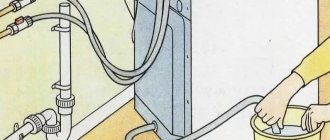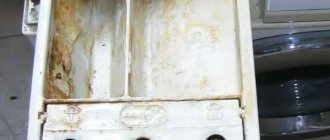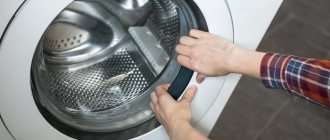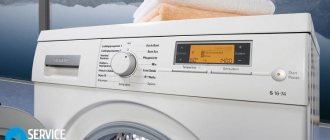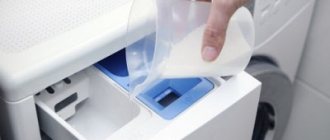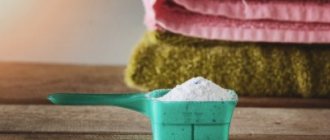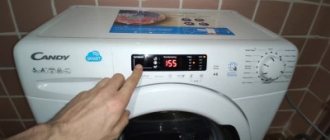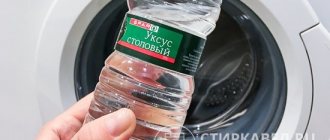Can bleach be added to the washing machine? The variety of detergents, bleaches and stain removers is pleasing, but also confusing. Which ones and when to use? Is it possible to combine them, what should I choose for hand washing, and which ones should I use in an automatic machine?
Especially many questions arise when using bleaches. I want to get a clean, white thing, but at the same time maintain its strength, not harm my health and not break the washing machine.
Types of bleaches
Rarely will a housewife tolerate yellowed and grayed things in her house. But color change is inevitable for white fabrics. To restore their freshness and whiteness with just one wash, you will need to use special preparations.
The times when the arsenal of bleaching products consisted only of bleach are long gone. Modern industry offers many options for chemicals. The whole variety of funds can be divided into three classes:
Oxygen
Such drugs appeared on the market not so long ago. However, due to the powerful but gentle influence, they immediately won the trust of the housewives. The line of these products is represented by hydrogen peroxide powder, to which additional substances (fragrances, softeners) are added. Oxygen bleaches will not ruin even the most delicate items. The only downside is the significant cost of these funds.
Optical
This type is not new at all. A substance such as blue, which was actively used in everyday life 40-50 years ago, was nothing more than an optical brightener. Absorbing the yellow color, ultramarine visually made things whiter. Modern industry offers more convenient and effective means.
But the principle of their effect is the same: to make the thing whiter using an organic dye. Optical brightener cannot clean the product or remove stains.
Oxygen bleaches
Popular brands:
- Vanish Oxi Action;
- Amway SA8 - for all types of fabrics;
- Oxy Crystal;
- "BOS plus Maximum";
- "Persol Master";
- Synergetic oxygen-containing.
The active principle of this type of bleach is atomic oxygen, released when the powder or gel is dissolved in water. The products act gently, do not destroy natural and synthetic fibers, and are suitable for hand and machine washing. However, the drugs are not potent: you may need to process things more than once to achieve the desired effect.
Rating for housewives
Chlorine
Chlorine bleach has been around for almost 100 years. They are presented on the market in both liquid and dry forms. Their popularity is explained simply: they are effective even in cold water, remove not only yellowness and grayness, but also stains, disinfect things and are affordable. But these funds also have plenty of disadvantages.
They can only be used on a narrow range of fabrics: cotton and linen, and only white. Bleach will simply ruin other things.
The use of such products can cause allergies and other serious health problems.
Dry
Oxygen-containing powder bleaches are suitable for use in automatic washing machines. There are products that start working at a water temperature of 40C. Most require heating up to 90C, but they also cost less.
Product for colored laundry
All oxygen-containing bleaches can be used when washing colored items. It will give them freshness and brightness of colors, this will be especially noticeable on contrastingly colored things.
How is it recommended to use whiteness for processing white products?
If you learn how to use Belizna correctly, you can quickly restore your favorite things at home without negative consequences. Experts and experienced users of the product recommend bleaching problem items using one of the following methods:
- To maintain the whiteness of fabric. Pour 10 liters of cool water into a basin, add two tablespoons of the product and stir. Soak white objects in the resulting liquid and leave for no more than 20 minutes. After this, you need to rinse the items and then they can be washed in the traditional way.
- To restore white color and eliminate grayness, spots, yellowness. In this case, you need to perform all the same manipulations, but the soaking time needs to be increased to one hour.
- To bleach very thick fabric. In this case, it is permissible to apply the pure product directly to the stain or unsightly stains. In this case, you need to wait no more than a minute before soaking the product in one of the universal solutions and then processing it in the traditional way.
Bleaching things with household bleach too often is not recommended. The approach is indeed very effective, but you can miss the point of thinning the fibers and ruin high-quality textiles.
Features of use when machine washable
When using bleaches, you must follow a number of important rules:
- pour or pour the product into a specially designed compartment, the location of which is indicated in the manual;
- use chlorine-containing products only if this is permitted in the instructions for the washing machine;
- wet, not dry, items should be placed in the machine drum;
- fragile, thin ones should not be washed for more than 15 minutes;
- After washing with bleach, be sure to rinse twice.
Features of using bleach
When working with aggressive chemicals, it is important to follow safety rules - not only sheets and washing machine parts can be damaged, but you too. Safety rules when working with chlorine-containing solutions:
- When bleaching, wear gloves and a mask. Contact of the substance with the skin causes burns, corrosion, and allergies.
- It is not advisable to use a stain remover on colored fabrics - the stain will come out, but along with it the color will lose its saturation.
- Do not use on leather, wool and silk items. Stains from them are generally very difficult to remove; compositions with chlorine will only spoil the material or cause the appearance of yellowness. Use is allowed on cotton, linen and synthetic fabrics.
- If the container with “Belizna” has been opened for a long time - six months or more, it is not worth using it, since the chemical effect of the composition is noticeably reduced.
Advantages and disadvantages of "Whiteness"
“Whiteness”, due to its versatility, is as popular as it was decades ago. This tool really has many advantages:
- works in both hot and cold water;
- used for disinfection, whitening, stain removal;
- quickly dissolves in water;
- It is characterized by economical use and low price.
“Whiteness” is a product that has been proven over the years and can be used to clean a washing machine. But this also comes with many disadvantages:
- An open container with a substance must be used quickly. After 2-3 months, the product will lose its effect.
- it has a characteristic pungent odor, which is not pleasant to everyone;
- the product may cause severe allergic reactions;
- do not use on delicate fabrics;
- in automatic machines, the product must be used very carefully, and the instructions must contain a direct indication of the possibility of using chlorine-containing bleaches.
Why do things spoil?
In order for the laundry to remain unharmed after treatment with “Whiteness”, it is not enough to know where to pour the product, you also need to know how to use it correctly. In case of violation of the rules:
- wear and tear of things accelerates;
- materials become thinner and worn out;
- things tear, holes appear on them.
Experts do not recommend using bleaches in SMA at all. But experienced people assure: it’s all about the technology of use and the correct dosage. If you do everything correctly, you can get rid of any stains, whiten fabrics and not damage the machine at all.
Cleaning
Washing machines often emit an unpleasant odor. It is caused by various reasons, but it is necessary to get rid of it.
Otherwise, clothes washed in such a machine will also smell musty.
To get rid of the smell of dampness you need:
- add powder and set the mode to 95C. After the end of the program, thoroughly wipe the drum, seal and ventilate;
- Pour at least 1 liter of “Whiteness” into the main wash compartment and set the temperature to maximum. When the machine body becomes warm, set it to pause. Leave for 1-2 hours, then drain the water. Set the “rinse” mode twice. The first time, add food vinegar to the air conditioner compartment; the second time, do not add anything.
Using bleach to clean your washing machine
If the rules for using the unit are violated, an unpleasant odor appears, which is quite difficult to get rid of. This happens in cases where:
- dry dirty things are stored in the machine until the required volume is reached;
- at the end of the process, the drum and rubber seal are not wiped from water, the loading door remains closed;
- Washing powder or other product not intended for your device is used to whiten items.
Residues of soap products settling on the drum cause mold to form, which gives off unpleasant odors. They are the ones who warn car owners that they should disinfect them in order to destroy harmful microorganisms that have appeared inside. In such cases, it is not recommended to load things into a bad-smelling washing machine, as they will acquire exactly the same odors, which will penetrate into the clothes and will haunt you for a long time.
To eliminate unpleasant odors in the washing machine, you can use one of two well-known methods. Powder without bleach must be poured into the compartment, the operating mode must be activated at a high temperature (90 - 95 degrees), and laundry must not be placed in the drum. This cleaning method is recommended to be used once every six months. Upon completion of the process, the drum and rubber seal are wiped dry, and the hatch remains open.
Whiteness should be poured in the amount of one liter into the compartment intended for the main wash. The program is set to the maximum temperature regime. When the loading door warms up, the washing machine stops temporarily or turns off completely. With Whiteness inside, the device needs to stand for a couple of hours, after which the draining and rinsing process is activated, while table vinegar is added to the conditioner tray. Repeated rinsing is carried out without adding detergent compounds.
You can clean your washing machine with Amway oxygen cleaner. In an amount of 100 ml it should be poured into the drum, after which the machine is turned on and the temperature is set to sixty degrees.
Restoring yellowed plastic
Over time, most white plastic cutlery will turn yellow. And the washing machine body is no exception. It is possible to return it to its former whiteness, and there are several ways to do this:
- Take 2 tbsp. washing powder, 2 tbsp. baking soda. Pour in 1 liter of water and stir. Apply the resulting mixture to the yellowed areas and leave for a couple of hours. Then rinse with warm water.
- Second way:
- Apply a few drops of ethanol alcohol to a cotton pad. Wipe the plastic thoroughly;
- moisten a clean rag with vinegar essence and treat the car;
- Purchase a spray to restore the whiteness of plastic surfaces from a specialized auto store.
How to dilute white for greenhouse treatment?
How to dilute “Whiteness” for eradication treatment? Pour 1 liter of “Whiteness” into ten liters of water, stir thoroughly and add one hundred grams of potassium monophosphate, stir until completely dissolved. Use immediately. It is better to process in calm weather, at a temperature of + 5 degrees.
Interesting materials:
What to do if it's very hot outside? What to do if your mobile phone gets wet? What to do if the memory card does not read? What to do if they don’t give you a paper sick leave? What to do if you can’t register for government services? What to do if the nut on the wheel does not unscrew? What to do if the monitor screen on the computer does not show? What to do if you don’t remember your computer password? What to do if you do not receive a receipt for payment of transport tax? What should I do if I haven’t received my e-ticket?
Tips and videos
- When bleaching, always remove metal parts from clothing;
- If you pour bleach directly into the machine drum, always dilute it with water. Otherwise, things may be damaged;
- after using chlorine bleach, use conditioner, it will give the laundry a pleasant aroma;
- At the end of the procedure, always rinse things twice.
The modern chemical industry offers a variety of products. Some of them are less effective, but at the same time environmentally friendly. Others act quickly and cope with the task efficiently. But they can damage fabrics and cause damage to the washing machine.
Therefore, most experts recommend not to overuse bleaching directly in the SMA. If you do this regularly, then follow all the specified precautions.
If you open one of the many forums dedicated to the care of household appliances, you will find that some housewives periodically pour White into the drum of their washing machines. However, experts are categorically against this approach, because Whiteness is a concentrate of aggressive chemical mixtures. Who should you trust: enthusiastic user reviews or recommendations from professionals? Is it possible to add whiteness to an automatic washing machine?
How to Use Fabric Bleach in the Washing Machine
In most cases, it is necessary to restore freshness to women's blouses, shirts, underwear and socks. Simply put, those things that end up in the washing machine more often than others. It is easy to wash and bleach small items by hand, using the product according to the instructions. But curtains or bedding will have to be washed in the machine.
For adding bleach to the washing machine, certain models (Lg, Indesit, etc.) have special trays with a triangle on them. In most cases, such a part is removable and is placed in the compartment for washing powders used in pre-washing. As a rule, such a compartment is marked with the letter A or the number I. This option is best suited for optical or oxygen compounds that are not included in detergents.
Housewives warn that it is not always recommended to pour White into the washing machine. First of all, you should carefully study the operating requirements for your washing machine. If the manufacturer allows the use of chlorine preparations, this means that all the main components of the machine are made of chlorine-resistant materials.
Still, where should you pour the bleach? The chlorine composition must be added in such a way that a minimum number of parts of the washing machine come into contact with it. Pour the product according to the indicated dosage, dissolve it in two to three liters of liquid, which is poured directly into the drum, along with the loaded items.
We suggest you familiarize yourself with How to choose a mink coat correctly: photo and video tips
Before the process begins, things must be sorted by white and colored shades and by type of material. Products with metal decorations, rivets, zippers or buttons are not subject to bleaching. The fact is that metal elements can darken, and the material around them will turn yellow.
If the instruction manual for your washing machine prohibits adding chlorine bleach, then the clothes are first soaked for a maximum of an hour in water with bleach added to it, and only then sent to the machine.
Whiteness is great for removing stains and bleaching fabrics. It is advisable to use it when washing by hand, but you can add a little solution to the machine. There are several ways to use Whiteness for whitening. You should consider the material from which the product is made. All this will help avoid damage to the item.
You can add it when washing nightgowns and pajamas, shirts and other light-colored items made of natural linen or cotton. Some resort to such an interesting method as decorating denim products with bleach. Chlorine-containing products can easily create streaks and various stains. Wool, synthetics, leather, organza, chiffon do not need to be bleached. The structure of delicate fabrics will be damaged and cannot be restored.
Pre-white clothes need to be sorted into several parts, for example, children's clothes, bed linen, cotton products. Clothing for babies must be rinsed several times so that any remaining product does not cause allergies. How to properly bleach laundry with Whiteness:
- pour cool water into a basin and add bleach (for 3.5 liters no more than 1 tbsp.);
- wet and soap clothes, paying attention to dirt;
- for soaking, leave in the solution for 15-20 minutes;
- Rinse clothes thoroughly several times.
You need to dry your clothes in the fresh air, as the product leaves a strong smell. To remove stains, simply dilute the bleach with a small amount of water and pour it only on the dirty areas.
It is not advisable to pour the substance into the washing machine - this can lead to damage or odors. The instructions for the device indicate whether bleach or powders containing it can be used. In addition, the instructions for using Whiteness are always described on its packaging. Machine washing step by step:
- sort things and wet them with cold water;
- select the temperature mode (you cannot wash things with the product in hot water);
- pour 1-2 tbsp. l. substances into the drum;
- After washing, rinse items several times with water.
Removing the machine from dirt and odor
The primary task of Whiteness is to rid the machine drum of the unpleasant musty smell that constantly plagues SM users. Moreover, such behavior can be caused by any careless action or neglect of the recommendations of specialists. Moreover, if you do not pay attention to this unpleasant symptom in time, the situation will only worsen, and you will have to take urgent measures.
As they say, it is easier to prevent a fire than to put it out. So here too, it is better not to bring the machine to a state where everything within a radius of two meters around it “smells” of mustiness. Here are the primary reasons for this phenomenon.
- Some housewives neglect special baskets for dirty laundry and put used clothes directly into the drum. Due to high humidity and the presence of bacteria, the smell begins to intensify and spread extremely quickly.
- An unpleasant smell will not be long in coming if you never ventilate the drum after washing. As soon as you close the door immediately after finishing work, the next time you are faced with a terrible stench from inside.
- The quantity and quality of household chemicals can also leave an impact. For example, if you pour or put too much powder or rinse aid inside or use low-grade products. In this case, fungus will begin to appear inside the machine, which will lead to the appearance of mold with a characteristic aroma.
These measures will help to avoid contamination and jamming of the machine if you start taking them on time. If the situation is already out of control, and measures need to be taken urgently, Whiteness can really have a miraculous effect. How to achieve it?
- First, pour a liter of White into the powder compartment.
- Start washing at the highest temperature possible. As a rule, it is 90-95 degrees.
- Wait until the machine door becomes quite hot and pause the wash. Now go about your business for a while.
Attention! To get rid of an unpleasant odor with the help of Whiteness, you need to wait at least two hours, otherwise all your efforts will be in vain. Although bleach is a strong chemical, it is not able to kill all colonies of bacteria in five minutes.
- After the required amount of time has passed, drain the water from the machine and turn on the rinse, while simultaneously pouring a little vinegar into the washing compartment.
- After the wash is finished, run the rinse cycle a few more times to remove the smell of chemicals and vinegar.
Precautions and recommendations for working with the product
Whitening using an aggressive component is only possible if the basic rules for using the product are followed. Ignoring them can end disastrously not only for the thing being processed, but also for health.
- It is allowed to work with the drug only with a mask and gloves; it is also advisable to stock up on plastic glasses. This will prevent skin corrosion, the development of burns of mucous membranes and the occurrence of allergies.
We recommend: Why does grandma pour salt into the toilet and sink?
Tip: If you place a bottle of bleach on the bottom during storage, you may have problems unscrewing the cap one day. It is better to place the container on its side, carefully closing it. Some manufacturers even began to produce their product in bottles with a round bottom, specifically forcing users to take this step.
- If during the bleaching process bleach gets on exposed skin or mucous membranes, you should immediately wash the affected area and see a specialist as soon as possible. It is prohibited to independently treat the resulting irritation or ulcers. New chemical reactions will only make things worse.
- Ingestion of the composition can cause severe poisoning, burns of the esophagus and tissue irritation, so the composition must be kept in a place inaccessible to children and pets.
- You should not try to remove stains from colored clothes using “Whiteness”. Along with the dirt, the color will come off and it will be impossible to restore it.
- You should not wash white leather, wool or silk with bleach. Delicate material, if it does not change its texture, will certainly turn yellow. No amount of stain removers or hydrogen peroxide will restore things to their original condition. “Whiteness” is best used for bleaching linen, cotton and very fine synthetics (if there are no prohibitory signs on the product label).
- “Whiteness” cannot be diluted in hot water. Such a combination of two already aggressive factors will not increase the effectiveness of the approach, but it is quite capable of reducing the strength of the fabric by thinning the fibers.
- Household chemicals should be stored in a dry, dark and fairly warm place. It is strictly forbidden to keep the bottle on the balcony in an attempt to get rid of the obsessive smell, especially in the winter months. Once frozen, the liquid almost completely loses its effectiveness.
- An open bottle should be used within six months. After this, the chemical composition of the product will noticeably change and its effectiveness will decrease. It can continue to be used, but the concentration of the composition in the water will have to be increased, and this can lead to damage to the item being bleached.
We recommend: How to make a soap-soda solution for household and medical needs
All rules are easy to follow. Compliance with them guarantees the safety of textile products during processing, and the housewife – the absence of unpleasant sensations and the prevention of additional problems.
Is whiteness harmful to the typewriter?
In order to settle this issue once and for all, an experiment was conducted. 15 liters of Whiteness were poured into the drum of a washing machine, which was far from new. Then an armful of rags was loaded into the unit and the wash started. It is worth noting that the SM was disconnected from the water supply, which means that the rags were washed in concentrated Whiteness.
After completing the disinfection process, the experimenters checked the insides of the machine, even the smallest parts: rubber bands, pipes. Everything was in perfect condition, not a single element was damaged, which, of course, could not be said about the rags. But the fact remains that it is safe to use white for SM.
Other ways to clean the machine
It would seem, why do we need more methods if there is already one, absolutely ideal one. But no, cleaning with White is not universal, as it does not help fight scale. This is where citric acid comes to the rescue.
- Take 60-100 grams of citric acid (the dosage depends on how much scale has attacked the machine) and pour it into the powder compartment.
- Place the wash in hot water, first turning on the rinse mode.
- Do not forget that cleaning should be done empty, without clothes.
Important! Monitor the operation of the SM; an unusual sound may appear. This means that scale fragments have entered the filter and must be removed to continue cleaning.
Vinegar has a similar effect, with the only difference being that it leaves behind a specific smell and requires a pause during cleaning for at least one hour. For the procedure, two glasses of vinegar slightly diluted with water are enough, which is poured directly into the drum.
You can also clean the machine with copper sulfate, diluting 30 grams of the substance per liter of water. Treat the insides and leave for 24 hours, and then run the machine twice: the first time with detergent, the second time without. In general, store-bought products are much better than homemade ones. Moreover, cleaning is carried out quite rarely, and buying a good substance will not hit your pocket hard.
Interesting:
- Share your opinion - leave a comment
From time to time, an unpleasant odor, scale and even mold appear in the washing machine. In such cases, cleaning is required. Many experienced housewives resort to using Whiteness. This is not an expensive, but very effective remedy, which, for sure, is in every home. But before you start the procedure, you need to know how to clean a washing machine with White correctly.
How to clean a washing machine with white: step-by-step instructions
Before you start cleaning your washing machine, make sure it is completely empty of all items. And then proceed with the following steps:
- Pour approximately 0.25 liters of bleach into the compartment of the container intended for washing powder;
- Start the machine automatically on intensive mode, maintaining 90°C;
- After completing the program, turn on the additional rinse mode again;
- Open the drum and wipe it dry, leaving the machine door open.
During treatment, all windows in the room should be opened for better ventilation, since chlorine vapors are quite toxic.
In addition to the drum, the remaining parts of the machine should also be washed.
Cleaning the rubber seal
Apply white to the elastic with a foam sponge soaked in it, move the seal cuff and treat all the gaps and folds, be sure to go through hard-to-reach places, this is where all the dirt accumulates, which later provokes the smell. Then wipe all parts with a rag or sponge dampened in clean water to remove any remaining whiteness.
Cleaning the powder compartment
Remove the container from the washing machine; to do this, you can use the instructions included with the machine. Then dip into a 1:1 solution of bleach and water to soak. Cleaning is also needed for the interior space where the container was located. For the most difficult to reach places, use a toothbrush.
Rinse all parts thoroughly with running water.
Cleaning the drain pump filter
The filter is located at the bottom of the machine. Before you start working, take a piece of thick fabric or a towel and place it under the bottom of the machine. Next, take a small container and place it under the filter. Unscrew the valve and spray white the entire surface available to you. Reinstall all disassembled parts in their places.
Cleaning the water drain pump filter
Turn off the water supply tap, unscrew the nut and carefully inspect the inside of the hose for foreign objects or debris. Empty the filter, treat it with a bleach solution in a 1:1 ratio, and then rinse under running water. Place all disassembled parts in their places and tighten with a nut.
Why does a washing machine drum get dirty?
There are several factors that can lead to contamination of equipment. And if you don’t pay attention to this in time, it will be much more difficult to get rid of the problem.
Let's look at the main reasons:
- Lack of cleaning . If you do not periodically clean the inside and outside of the washing machine, such neglect will lead to the accumulation of dust and dirt. Dirt will begin to accumulate in the hose, and this is the result of a clogged drain system.
- Hard water. Frequent contact with hard water will lead to the formation of a layer of scale. The fact is that tap water contains a lot of impurities. They settle on the insides of the drum and internal components.
- Lack of ventilation. If the operating rules are violated, the service life of the equipment is significantly reduced. If you do not ventilate the drum after each wash, leave wet items for a long time, or load laundry carelessly - all this leads to the proliferation of pathogenic microorganisms (bacteria) and the appearance of mold.
- Use of low-quality powders. Cheap detergents leave a soap residue after washing. This may be the result of fungi.
- Woolen underwear . In any case, washing woolen clothes leads to the fact that during the procedure itself, the fibers of the fabric begin to spread along with the water throughout the machine.
What does whitewash clean the washing machine from?
Constant and high-quality cleaning of your washing machine with white will help you not only keep it clean, ensure trouble-free operation, but also preserve your clothes.
Different parts of the machine are prone to different types of contamination, let's look at where and what compounds can accumulate them and what chlorine bleach can handle:
- Sealing rubber, under it moldy fungi usually form, leading to a disgusting odor;
- Heating elements, depending on the hardness of the water, scale forms on them; drain pump filter, dirt, undissolved washing powder crystals and bad
- Rinsed conditioner;
- The inlet hose filter is prone to rust.
If you don't want such troubles, use bleach and disinfectant.
What happens if you don’t clean the washing machine drum?
If you refuse such a simple procedure, you may end up with unpleasant consequences, for example, breakdown of the unit followed by expensive repairs. The service life of a washing machine is approximately 10 years. But if you do not follow simple care rules, then due to the formation of greasy deposits, mold, and scale, it will not last even 3-4 years.
Lack of care can result in the following problems:
- Dirt and grease will begin to collect on the hose and pipes. This will end with the drain system becoming clogged and the pump impeller blocking.
- A layer of scale will accumulate on the heating element. Over time, it will increase in volume, and as a result will cover the entire heating element. Such a shell of scale will lead to overheating and failure.
- Sand, scale, and rust will begin to accumulate in the place where the inlet filter and hose are connected. Such debris will lead to clogs and leaks.
- Mold and unpleasant odor that appears in the drum will affect the quality of the wash. If you leave wet laundry for 2-3 days, fungal spores will instantly penetrate the fibers of the fabrics, and even after cleaning, dark spots of mold can be seen on the clothes.
Now we can safely answer the question whether it is possible to clean the drum of a washing machine with White. This is an inexpensive chlorine product that can be used to easily get rid of problems with your washing machine. The most important thing is to adhere to the specified dosage and always ventilate the drum after the procedure to remove moisture.

